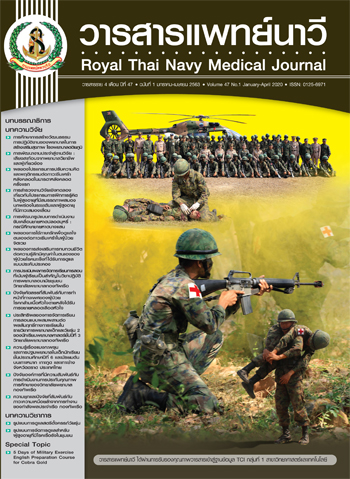Model of Care for Pregnant Adolescents
Main Article Content
Abstract
This thematic paper aimed at reviewing research evidence-based on model of care for pregnant adolescents. A total of 13 research evidence-based studies were selected. Of these, one was a meta-analysis of experimental studies (Level 3), three were quasi-experimental studies (Level 5), five were retrospective studies (Level 5), two were observational studies (Level 5), and two were prospective studies (Level 5). The selected research studies were evaluated and synthesized. The study findings regarding model of care for pregnant adolescents were as follows: 1) The programs continuously disseminated knowledge during pregnancy on self-care practices and care of the fetus by offering consultancy based on individuals’ problems, 2) Continuous and comprehensive care was provided by a multi-disciplinary team by specifying the care guideline, knowledge dissemination, and roles of healthcare team members based on their specialization, 3) The antenatal care clinics/ programs were established to solve problems related to health risk behaviors and psychosocial risks with an emphasis on screening and problem-solving together with provision of information and counseling specifically to problems of individual pregnant adolescents, and 4) Caring was continuously offered by case managers who ensure continuity of care from pregnancy to delivery periods. The review showed that antenatal care programs for pregnant adolescents resulted in positive pregnancy outcomes and desirable behaviors during the postpartum period.
Based on the study findings, it is recommended that model of care for pregnant adolescents should be continuously provided by case managers in collaboration with multidisciplinary team members to assess problems related to physical well-being, psycho-social well-being, and risk behaviors of pregnant adolescents. Moreover, information and advice should be offered to cover all stages of the pregnancy in accordance with problems of each pregnant adolescents. Advice should also be given to ensure appropriate practice during the postpartum period. Finally, a continuous care guideline should be developed, and training on case management should be organized to ensure quality of care provided to pregnant adolescents.
Article Details

This work is licensed under a Creative Commons Attribution-NonCommercial-NoDerivatives 4.0 International License.
References
World Health Organization. World health statistics: Geneva: WHO; 2010.
Unicef Thailand. Multiple indicator cluster survey 2015-2016. [Internet]. [cited 2012 September 22]. Available from: https://www.unicef.org/thailand/media/176/file/Key%20
Findings%20from%20Thailand%20Multiple%20Indicator%20Cluster%20Survey%202015-2016%20(English).pdf.
Black AY, Fleming NA, Rome ES. Pregnancy in adolescents. Adolesc Med State Art Rev 2012;23(1):123-38.
Lopez, FP, Chedraui P, Kravitz AS, Pousada DS, Hidalgo L. Present problems and controversies concerning pregnant adolescents. Journal of Gynecology & Obstetrics 2011;2011(2):85-94.
Dubhashi SS, Wani RJ. Teenage Pregnancy. Journal Bombay Hospital 2008;50(2):236-39.
Wiemann CM, Rickert VI, Berenson AB, Volk RJ. Are pregnant adolescents stigmatized by pregnancy. Journal of Adolescent Health 2005;36(4):352-60.
Ryan JA, Casapía M, Aguilar E, Silva H, Joseph SA, Gyorkos TW. Comparison of prenatal care coverage in early adolescents late adolescents and adult pregnant women in the Peruvian Amazon. Int J Gynaecol Obstet 2009;107(2):162-5.
Montgomery KS. Improving nutrition in pregnant adolescents: recommendations for clinical practitioners. J Perinat Educ 2003;12(2):22-30.
Alwahab AA. Pregnancy complication and outcome among Journal Thi-Qar Medical 2011;5(3):87-93.
Kumar A, Singh T, Basu S, Pandey S, Bhargava V. Outcome of teenage pregnancy. Indian J Pediat 2007;74(10):927-31.
Phanthumat S. Factors related to self-care behaviors among primigravida teenagers in Ubonratchathani. [Master’s Thesis, Faculty of Public Health]. Mahidol University; 2012. (in Thai).
Chen XK, Wen SW, Fleming N, Demissie K, Rhoads GG, Walker M. Teenage pregnancy and adverse birth outcomes a large population based retrospective cohort study. Int J Epidemiol 2007;36(2):368-73.
Kalaivani K. Prevalence & consequences of anemia in pregnancy. Indian J Med Res 2009;130(5):627-33.
Ehrenberg HM, Dierker L, Milluzzi C, Mercer BM. Low maternal weight failure to thrive in pregnancy and adverse pregnancy outcomes. American Journal of Obstetrics and Gynecology 2003;189(6):1726-30.
Williamson CS. Nutrition in pregnancy. Nutrition Bulletin 2006;31(1):28-59.
Wise NJ, Arcamone AA. Survey of adolescent views of healthy eating during pregnancy. The American Journal of Maternal Child Nursing 2011;36(6):381-6.
Dubois S, Coulombe C, Pencharz P, Pinsonneault O, Duquette MP. Ability of the Higgins nutrition intervention program to improve adolescent pregnancy outcome. Journal of the American Dietetic Association 1997;97(8):871-8.
Gilbert W, Jandial D, Field N, Bigelow P, Danielsen B. Birth outcomes in teenage pregnancies. Journal Matern Fetal Neonatal Med 2004;16(5):265-70.
Grace J. Essential skills for evidence-based practice: strength of evidence. J Nurs Sci 2009;27(2):8-13.
Mersal FA, Esmat OM, Khalil GM. Effect of prenatal counselling on compliance and outcomes of teenage pregnancy. East Mediterr Health J 2013;19(1):10-7.
Grady MA, Bloom KC. Pregnancy outcomes of adolescents enrolled in a centering pregnancy program. J Midwifery Womens Health 2004;49(5):412-20.
Pinto e Silva JL. Pregnancy during adolescence: wanted vs. unwanted. Int J Gynaecol Obstet 1993;63Suppl 1:S151-6.
Smoke J, Grace MC. Effectiveness of prenatal care and education for pregnant adolescents nurse-midwifery intervention and team approach. Journal of Nurse-Midwifery 1988;33(4):178-84.
Quinlivan JA, Evans SF. Teenage antenatal clinics may reduce the rate of preterm birth: a prospective study. BJOG 2004;111(6):571-8.
Rabin JM, Seltzer V, Pollack S. The long term benefits of a comprehensive teenage pregnancy program. Clin Pediatr (Phila) 1991;30(5):305-9.
Slager-Earnest SE, Hoffman SJ, Beckmann CJ. Effects of a specialized prenatal adolescent program on maternal and infant outcomes. J Obstet Gynecol Neonatal Nurs 1987;16(6):422-9.
Koniak-Griffin D, Mathenge C, Anderson NL, Verzemnieks I. An early intervention program for adolescent mothers a nursing demonstration project. J Obstet Gynecol Neonatal Nurs 1999;28:51-9.
Hardy JB, King TM, Repke JT. The Johns Hopkins adolescent pregnancy program an evaluation. Obstet Gynecol 1987;69(3 Pt 1):300-6.
Korenbrot CC, Showstack J, Loomis A, Brindis C. Birth weight outcomes in a teenage pregnancy case management project. J Adolesc Health Care 1989;10(2):97-104.
Kittipibul S. Teenage pregnancy at Trat Hospital. J Prapokkloa Hosp Clin Med Educated Center 2010;27(2):107-14. (in Thai).


